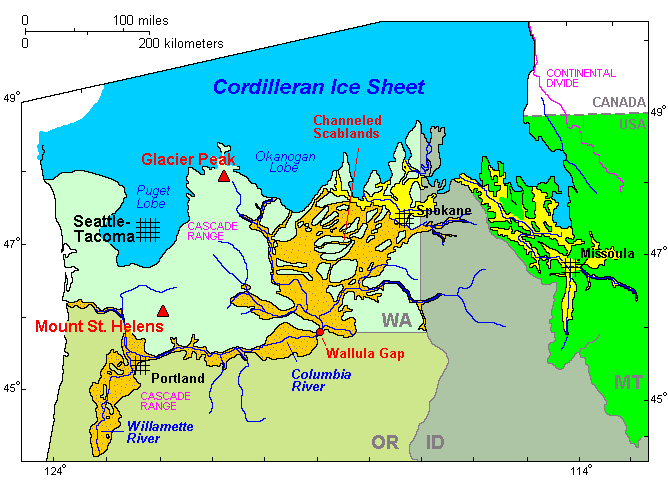One of the beautiful things about canyons is that they have steep walls, and the beauty of steep walls is that they create wonderful waterfalls. Here is the most famous one in Oregon, and no wonder: a narrow, 542-foot fall, followed by another drop of 69 feet before emptying into the Columbia River. Also famous because it's so accessible: just 40 minutes from downtown Portland, via Interstate Highway 84. If you were looking for that solitary wilderness experience, never mind; but if you're wiling to share a spot of amazing beauty with a few hundred other people, by all means pull off the highway and visit Multnomah Falls.
 The Columbia River Gorge, home to Multnomah Falls, has a remarkably ancient history. There seems to have been a river here at least 12 million years ago, making it older than the Cascade Mountains. When the Cascades began their uplift, they deflected the river to the north, creating that conspicuous bend downstream of Portland, where the Willamette flows into the Columbia.
The Columbia River Gorge, home to Multnomah Falls, has a remarkably ancient history. There seems to have been a river here at least 12 million years ago, making it older than the Cascade Mountains. When the Cascades began their uplift, they deflected the river to the north, creating that conspicuous bend downstream of Portland, where the Willamette flows into the Columbia.By then, there was probably some sort of canyon here, but the major action occurred only 12-15,000 years ago. During the most recent ice age, expanding glaciers would block up the Clark's Fork River in Montana, creating a vast lake (known as "Glacial Lake Missoula") behind an ice dam. Periodically, the dam would fail, sending some 500 cubic miles of water rushing through Couer d'Alene and eastern Washington at speeds estimated to be as high as 65 MPH. Imagine the combined waters of Lakes Erie and Ontario being emptied in two days - that's what it was like. By the time this water reached the Pacific, it had left behind a deeply scoured landscape in Washington and a wider, deeper Columbia River Gorge. And this flood didn't happen only once, because the ice dam would slowly reform, until it had built up a large enough reservoir to undermine itself again. It happened a least a couple dozen times over several thousand years.1

Multnomah Falls is such a rewarding stop that it comes as a slight surprise that Lewis and Clark didn't single it out for special praise. But it makes sense, because there are more waterfalls than this along the Columbia River Gorge and foot travelers would have seen many of them. L&C merely commented that
several small streams fall from a much greater hight, and in their decent become a perfect mist which collecting on the rocks below again become visible and decend a second time in the same manner before they reach the base of the rocks.However understated, Cpt. Lewis always had an eye for the scenery.
Bonus: a Wasco legend on the origins of Multnomah Falls. The setting of the story, a devastating epidemic of incredible suddenness and mortality, makes me think this legend doesn't predate European contact. Or perhaps it only means that an ancient legend was retold to reflect more recent experiences.
_______________________________________
1. For more information, see Cascades Volcano Observatory - Glacial Lake Missoula; Digital Geology of Idaho - Lake Missoula Floods; GlacialLakeMissoula.org. As always, Wikipedia was also consulted.



No comments:
Post a Comment